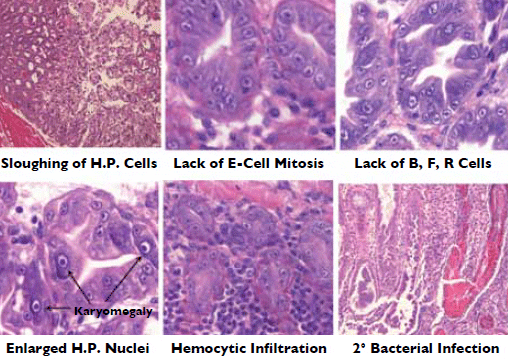The Asia-Pacific region, the top producer
of aquaculture products in the
world, is continuously beset by emerging
aquatic animal disease problems that can
cause high mortalities and economic losses
among small farmers as well as commercial
producers. Over the last couple of decades,
diseases such as white spot syndrome, yellowhead disease and Taura syndrome
heavily impacted shrimp aquaculture in
the region and caused the collapse of the
Penaeus monodon industry.
More recently, an emerging disease
known as early mortality syndrome (EMS)
also termed acute hepatopancreatic
necrosis syndrome or AHPNS caused
significant losses among shrimp farmers in
China, Vietnam and Malaysia. It also
reportedly affected shrimp in the eastern
Gulf of Thailand this year (Flegel, 2012).
EMS affects both P. monodon and
Litopenaeus vannamei and is characterized
by mass mortalities during the first 20 to
30 days of culture in growout ponds.
Clinical signs of the disease include slow
growth, corkscrew swimming, loose shells
and pale coloration. Affected shrimp consistently
show abnormal shrunken, small,
swollen or discolored hepatopancreases.
EMS Pathology
The primary EMS pathogen has not
been identified, but the presence of
microbes including vibrios, microsporidians
and nematodes has been observed in
some samples. Histological work by Dr.
Donald Lightner and co-workers showed the effects of EMS appeared to be limited
to the hepatopancreas.
The pathology included a lack of
mitotic activity in generative E cells; dysfunction
of central hepatopancreatic B, F
and R cells; and massive sloughing of
central tubule epithelial cells. Terminal
stages showed massive intertubular
hemocytic aggregation followed by secondary
bacterial infections.
Similar histopathological results were
obtained by Anuparp Prachumwat and
co-workers for Thai samples of P. vannamei
collected from Chantaburi and Rayong
provinces in late 2011 and early 2012
(Figure 1). The progressive dysfunction
of the hepatopancreas (H.P.) results from
lesions that reflect degeneration and dysfunction
of the tubule epithelial cells that
progress from the proximal to distal ends
of H.P. tubules. This degenerative
pathology strongly suggests a toxic etiology,
but anecdotal information suggests
that disease spread patterns may be consistent
with an infectious agent.
Serious Losses
In China, the occurrence of EMS in
2009 was initially ignored by most farmers.
But in 2011, outbreaks became more serious,
especially at farms with more than five years
of culture history and those close to the sea
using very saline water. Shrimp farming in
Hainan, Guangdong, Fujian and Guangxi
suffered almost 80% losses during the first
half of 2011 (Panakorn, 2012).
In Vietnam, the disease has been
observed since 2010, but the most widespread devastation due to EMS has been
reported since March 2011 in the Mekong
Delta in southern Vietnam. EMS affects the
main shrimp production areas of Tien Gang,
Ben Tre, Kien Giang, Soc Trang, Bac Lieu
and Ca Mau provinces, and a total
shrimp pond area of around 98,000 ha.
In June 2011, unprecedented losses
were reported for 11,000 ha of P. monodon
farms in Bac Lieu. Some 330 million
shrimp died in Tra Vinh, and 20,000 ha in
Soc Trang suffered huge losses this year
(Mooney, 2012).
In Malaysia, EMS was first reported in
mid-2010 in the east coast states of Pahang
and Johor. The outbreaks of EMS resulted
in a drop in L. vannamei production from
70,000 mt in 2010 to 40,000 mt in 2011.
Poor production is expected for 2012 with
unconfirmed reports of EMS in the states
of Sabah and Sarawak.
So far, no potential causative pathogen
has been found for EMS. Possible etiologies
include biotic or abiotic toxins, bacteria
and viruses. Nonetheless, the spread of the
disease and its devastating effects on the
shrimp industries of the countries affected
point to the need for contingency planning
in other countries in the region, especially
those that practice L. vannamei culture.
Prepare, Report
Identifying the primary cause of EMS
is important, but until this information is
available, increased awareness and preparedness
should be implemented by all
shrimp-producing countries in the region.
Concerned experts, officials and regulatory
bodies should formulate ways to prevent
the spread and/or occurrence of this disease.
Farmers should cooperate with the concerned
agencies by promptly reporting any
suspected mortalities among cultured shrimp
that display signs of EMS. It is also important
that histological examinations be carried
out to confirm that suspected occurrences fit
the EMS/AHPNS case definition.

September 2012




